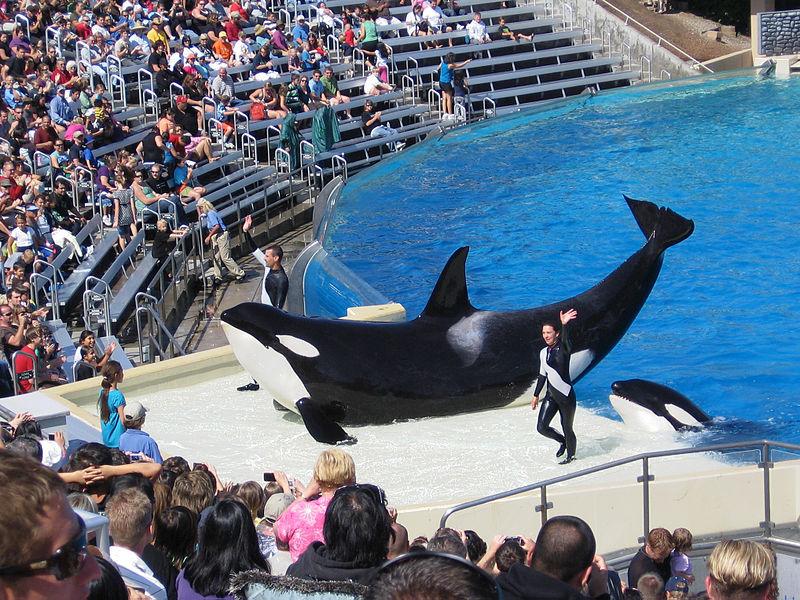Lawson: Slavery of the marine kind
September 4, 2015
Animals in captivity have made many people rich. People pay to go to animal entertainment parks to observe and “learn” more about these animals. You know what else you can do to learn more about animals? Watch documentaries, read books and magazines or study about them and become an animal expert.
What you don’t do is pay loads of money to watch orcas, dolphins or any other animals wander around aimlessly for your entertainment at the expense of the animals.
SeaWorld was founded March 15, 1959 and is best known for its orca shows. It has many whales in its tanks and train them to perform tricks for “entertainment” purposes.
SeaWorld captured its first orca —. It would steal these animals from their homes and then send them to training camps so the orcas could perform tricks on command and make the company thousands of dollars.
It also doesn’t hurt to mention that between 1961 and 1964, several whales died or were killed by lethal force because the people who captured them didn’t know what they were doing.
In 2013, SeaWorld was exposed by the popular documentary “Blackfish.” The focus of the film was one whale in particular, Tilikum, but it also exposed the other malpractices of SeaWorld. The filmmakers focused on Tilikum because he has been involved in three deaths of trainers since his capture. Since the release of “Blackfish,” SeaWorld’s profits and attendance have dropped.
Additionally, SeaWorld has made enemies of several animal welfare groups during the unraveling of its reputation. In particular, People for the Ethical Treatment of Animals, better known as PETA, has taken a special interest in SeaWorld and is well aware of the injustices taking place within those concrete walls.
PETA has launched a campaign against SeaWorld called SeaWorld of Hurt that calls for the release of all the animals. Since the success of “Blackfish,” SeaWorld has tightened and limited all communications with the public.
Although SeaWorld shared that its attendance and revenues have dropped, there are no signs it will be release its animals and focus on other streams of revenue.
SeaWorld appears to be following the example set by Miami Seaquarium and its captive whale Lolita. Lolita is the star attraction of the park, but she is known as the loneliest whale in the world.
She has not seen another whale since the 1980s when her tankmate Hugo killed himself.
Hugo died of a brain aneurysm from beating his own head against the walls and windows. He once hit the windows so hard he broke some plastic from the bubble window, which shaved off an inch from his nose, which then had to be stitched back onto his face.
The animals SeaWorld exploits are social and intelligent. They need to be free to be fully alive. They swim hundreds of miles a day. They have a familiar social structure known as pods.
The orcas that are in captivity do not exhibit normal orca behavior. They only float around their tanks. Because of the depression caused by captivity, the whales at SeaWorld parks have become susceptible to new dangers.
Some whales have died from contracting West Nile virus, which wouldn’t happen in the ocean. They have also received sunburns from floating, which would only happen in captivity.
The first step to end captivity is to stop the breeding program. Because of the relative success of the program, there are inbred whales or whales that reject their young. When SeaWorld cannot replenish its tanks, it cannot keep this cycle of captivity alive.
For whales born in captivity, there is a chance to be free in a controlled environment. Since most of the captive whales are inbred, they will most likely be rejected from wild pods. They don’t know natural whale behaviors, and even if they succeed in developing those behaviors, there is no guarantee that pods would accept them, which is why whales should be housed in sea pens if they must remain in captivity.
In sea pens, the whales are re-exposed to the natural waters they were stolen from. They are introduced to hunting for food, holding their breath for long periods of time and swimming. They need to have these basic skills in order to joining pods and be successful in their natural environments. Whales in sea pens can be monitored by a team to ensure their successes.
For these whales, permanent sea pens would be best the best option. This way they can experience what the ocean is and have a level of freedom. The captive-born whales have a lot of obstacles to overcome, but I believe they can live good lives outside of SeaWorld. They can live in sea pens until the end of their lives and still have a higher quality of life than at SeaWorld and its affiliates.
The end of captivity is in our hands. If people stop going to animal “entertainment” parks then there is no longer a demand for their capture or breeding. Stop going to SeaWorld. Stop supporting its parent and sister companies. When we stop the flow of money, we can see that these animals live the lives that were intended for them.

















